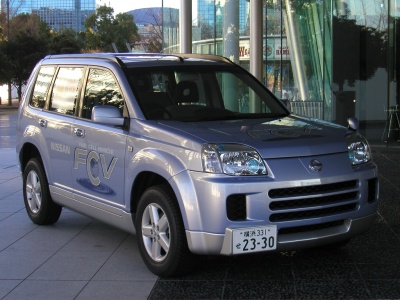 From the Editors of E/The Environmental Magazine
From the Editors of E/The Environmental Magazine
Dear EarthTalk: What are the environmental pros and cons of corn-based plastic as an alternative to conventional petroleum-based plastic? -- Laura McInnes, Glasgow, Scotland

A cup made from PLA, plastic made from cornstarch. (Photo: Bec, courtesy Flickr)
Polylactic acid (PLA), a plastic substitute made from fermented plant starch (usually corn) is quickly becoming a popular alternative to traditional petroleum-based plastics. As more and more countries and states follow the lead of China, Ireland, South Africa, Uganda and San Francisco in banning plastic grocery bags responsible for so much so-called "white pollution" around the world, PLA is poised to play a big role as a viable, biodegradable replacement.
Proponents also tout the use of PLA-which is technically "carbon neutral" in that it comes from renewable, carbon-absorbing plants-as yet another way to reduce our emissions of greenhouse gases in a quickly warming world. PLA also will not emit toxic fumes when incinerated.
But critics say that PLA is far from a panacea for dealing with the world's plastic waste problem. For one, although it does biodegrade, it does so very slowly. According to Elizabeth Royte, writing in Smithsonian, PLA may well break down into its constituent parts (carbon dioxide and water) within three months in a "controlled composting environment," that is, an industrial composting facility heated to 140 degrees Fahrenheit and fed a steady diet of digestive microbes. But it will take far longer in a compost bin or in a landfill packed so tightly that no light and little oxygen are available to assist in the process. Indeed, analysts estimate that a PLA bottle could take anywhere from 100 to 1,000 years to decompose in a landfill.
Another issue with PLA is that, because it is of different origin than regular plastic, it must be kept separate when recycled, lest it contaminate the recycling stream. Being plant-based, PLA needs to head to a composing facility, not a recycling facility, per se, when it has out served its usefulness. And that points to another problem: There are presently only 113 industrial-grade composting facilities across the U.S.
Another downside of PLA is that it is typically made from genetically modified corn, at least in the U.S. The largest producer of PLA in the world is NatureWorks, a subsidiary of Cargill, which is the world's largest provider of genetically modified corn seed. With increasing demand for corn to make ethanol fuel let alone PLA, it's no wonder that Cargill and others have been tampering with genes to produce higher yields. But the future costs to the environment and human health of genetic modification are still largely unknown and could be very high.
While PLA has promise as an alternative to conventional plastic once the means of disposal are worked out, grocery shoppers could do well to by simply switch to reusable containers, from cloth bags, baskets and backpacks for grocery shopping (most chains now sell canvas bags for less than a dollar apiece) to safe, reusable (non-plastic) bottles for beverages. As for other types of PLA items-such as those plastic "clamshells" that hold cut fruit (and there is a whole host of industrial and medical products now made from PLA)-there is no reason to pass them by. But until the kinks are worked out on the disposal and reprocessing end, PLA may not be much better than the plain old plastic it's designed to make obsolete.
CONTACTS: Smithsonian's "Corn Plastic to the Rescue," www.smithsonianmag.com/science-nature/plastic.html; NatureWorks, www.natureworksllc.com.
Dear EarthTalk: How is it that hydrogen can replace oil to run our cars? There seems to be a lot of controversy over whether hydrogen can really be generated and stored in such a way to be practical? -- Stephane Kuziora, Thunder Bay, ON

Nissan's hydrogen-fueled X-TRAIL FCV fuel cell vehicle. (Photo: Donbraco, courtesy Flickr)
The jury is still out on whether hydrogen will ultimately be our environmental savior, replacing the fossil fuels responsible for global warming and various nagging forms of pollution. Two main hurdles stand in the way of mass production and widespread consumer adoption of hydrogen "fuel cell" vehicles: the still high cost of producing fuel cells, and the lack of a hydrogen refueling network.
Reining in manufacturing costs of fuel cell vehicles is the first major issue the automakers are addressing. While several have fuel cell prototype vehicles on the road-Toyota and Honda are even leasing them to the public in Japan and California-they are spending upwards of $1 million to produce each one due to the advanced technology involved and low production runs. Toyota hopes to reduce its costs per fuel cell vehicle to around $50,000 by 2015, which would make such cars economically viable in the marketplace. On this side of the Pacific, General Motors plans to sell hydrogen-powered vehicles in the U.S. by 2010.
Another problem is the lack of hydrogen refueling stations. Major oil companies have been loathe to set up hydrogen tanks at existing gas stations for many reasons ranging from safety to cost to lack of demand. But obviously the oil companies are also trying to keep customers interested in their highly profitable bread-and-butter, gasoline. A more likely scenario is what is emerging in California, where some 38 independent hydrogen fuel stations are located around the state as part of a network created by the non-profit California Fuel Cell Partnership, a consortium of automakers, state and federal agencies and other parties interested in furthering hydrogen fuel cell technologies.
The benefits of ditching fossil fuels for hydrogen are many, or course. Burning fossil fuels like coal, natural gas and oil to heat and cool our buildings and run our vehicles takes a heavy toll on the environment, contributing significantly to both local problems like elevated particulate levels and global ones like a warming climate. The only by-product of running a hydrogen-powered fuel cell is oxygen and a trickle of water, neither of which will cause any harm to human health or the environment.
But right now 95 percent of the hydrogen available in the U.S. is either extracted from fossil fuels or made using electrolytic processes powered by fossil fuels, thus negating any real emissions savings or reduction in fossil fuel usage. Only if renewable energy sources-solar, wind and others-can be harnessed to provide the energy to process hydrogen fuel can the dream of a truly clean hydrogen fuel be realized.
Stanford University researchers in 2005 assessed the environmental effects of three different hydrogen sources: coal, natural gas, and water electrolysis powered by wind. They concluded that we'd lower greenhouse gas emissions more by driving gasoline/electric hybrid cars than by driving fuel cell cars run on hydrogen from coal. Hydrogen made using natural gas would fare a little bit better in terms of pollution output, while making it from wind power would a slam-dunk for the environment.
CONTACT: California Fuel Cell Partnership, www.fuelcellpartnership.org.
GOT AN ENVIRONMENTAL QUESTION? Send it to: EarthTalk, c/o E/The Environmental Magazine, P.O. Box 5098, Westport, CT 06881; or e-mail: earthtalk@emagazine.com.


